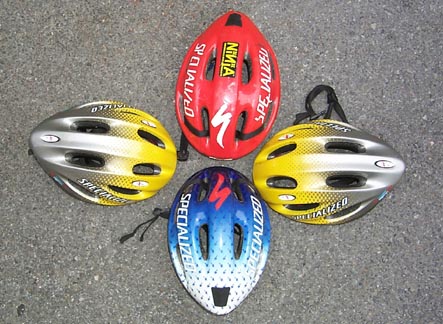Protect
your melon
It is no news to anyone
that wearing a bike helmet could save your life. In fact, they reduce the risk
of head injuries by 85% according to the Bicycle Helmet Safety Institute.
Although awareness campaigns seem to have little residual effect on helmet wear
patterns once the campaign is over, state and provincial laws requiring
mandatory helmet use do. I have heard several reasons people have for not
wearing a helmet: they are too ugly, too hot, uncomfortable, too expensive,
uncool, “I am too good, so I don’t need to wear one” or my favorite, it is
their right to choose not to wear one. While some people are exercising their
right to be ignorant, 797 cyclists were killed in motor vehicle accidents in
1996, 96% of them were not wearing a helmet.
The issue for inline
skaters may not be whether or not to wear a helmet, but which one to
choose. As of February 1999, it has become easier to know which helmets
meet federal safety standards set by the Consumer Product Safety Commission
(CPSC). Whereas in the past, you might have been confronted with as many as 3
safety approval stickers, now there is only one. Helmets must now meet CPSC
standards for impact, “roll off” (how well the helmet stays on during an
accident) and strap strength.
Proper helmet wear
Before your helmet can
protect you, obviously you must be wearing it, and wearing it correctly. Take
your time in selecting your helmet. Manufacturers have addressed many of the
complaints people have had with first generation models and have developed
light, comfortable, well ventilated, aerodynamic and cool looking lids. Visors
can help keep the sun out of your eyes, but if they don’t break away in an
accident, they can grab onto something twisting your head and increase the risk
of injury. Bright colors and reflectors also help you be more visible to
motorists, and match your skinsuit.
Don’t laugh, but I have seen many people wearing their helmet backwards. Other no-no’s, include loose chin straps, or the front of the helmet pointing up towards the sky. The helmet should be worn flat across your head, with the brow about one inch above your eyebrows. The straps should form a “V” just below your ears. Many helmets now come with hinged snaps so that you can adjust the straps around the ear. If you can stick more than one finger between your chin strap and your chin, they are too loose and need to be tightened. Look for helmets that come with different sized detachable velcro fitting pads. These do not offer added protection, but they help keep the helmet positioned properly and comfortably. Rear stabilizers like the Louis Garneau Spider Lock system, also encourage proper helmet positioning and help keep it in place.

Replace your helmet after it has received a blow! It’s job is done. It may
look unharmed because the plastic shell bounces back to its original shape, but
the foam underneath may have been damaged and may not protect you as well in
the future. For this same reason, avoid buying used helmets. Manufacturers may
replace damaged helmets for a slight fee, but you will most likely have to
return your helmet, which leaves you somewhat naked.
The truth about helmets
Consumer reports tested
24 helmets for their June 1999 report. They looked at models from 9 brands
including Bell, Giro, Specialized, and GT. They also tested helmets that cost
less than 30$ the Wal-Mart, Toys R Us or Canadian Tire brands. The good news
is, all tested helmets passed the impact test based on the new CPSC standards.
Two helmets were black marked: the adult GT Stinger and the toddler sized PTI
Kid Cats because their straps stretched beyond acceptable limits.
The overall score was based on impact absorption. The tested helmets were mounted onto a metal head and dropped from various heights. Other aspects were also tested. Straps were tested to see how well they kept the helmet in place under the stress of a sudden jerk. Fit was measured by how easy it was to adjust straps and to use the fitting pads to get a snug, secure fit. Finally, the ventilation was tested to see how moisture evaporated from a test “head” covered with a wet cloth, helmeted and placed in a wind tunnel.

The bottom line
Consumer Reports
recommends the Louis Garneau Globe, The Trek Vapor (Best Buy) and the GT Gator.
All three had very good impact ratings, are reasonably priced and weight
between 9 and 11 ounces. For children between the ages of 5 and 14 top honors
went to the Giro Wheelie, while the standout helmet for toddlers was the Bell
Half Pint Pro.
The Louis Garneau Globe
had the best impact rating of all tested helmets. The Bell EVO 2 Pro, Trek
Vapor, GT Gator, Schwinn Typhoon, and Specialized Air Wave had very good impact
ratings. In the youth models, the Giro Wheelie, Bell Mischief Pro, Pro Action
Voltage, PTI Barbie, Schwinn Trasher, and Specialized Air Wave Mega all had
very good impact ratings. For toddlers, the Bell Half Pint Pro and the PTI Kids
Cats were top scorers. Strap fit seemed to be good for all adult, youth and
toddler models. Fit on the other hand received very good ratings on the Bell
EVO 2 Pro, the Louis Garneau Globe, and several Giro models. For youth helmets,
the Giro Wheelie, Bell Mischief Pro, and Trek Scout, also received above
average fit ratings. Toddler models Bell Half Pint Pro and GT Lil Thunder were
the best rated for fit. Ventilation was rated as excellent on Girro models,
above average on the Bell Evo Pro, and for the Gt Gator. Ventilation was not
rated for youth and toddler helmets.
If you want to see how
your helmets rates, visit the Consumer Protection website
www.consumerreports.org.